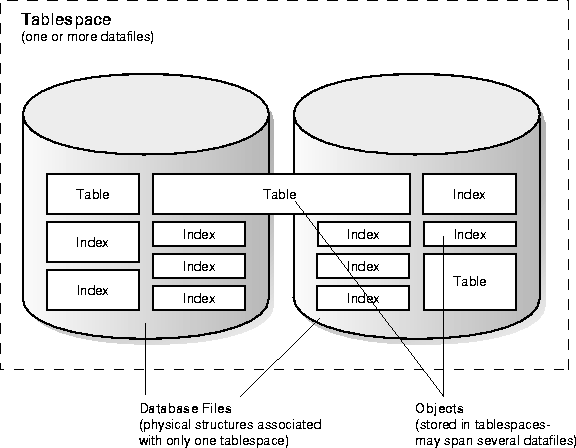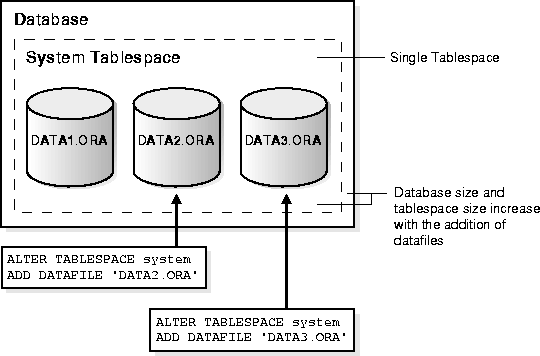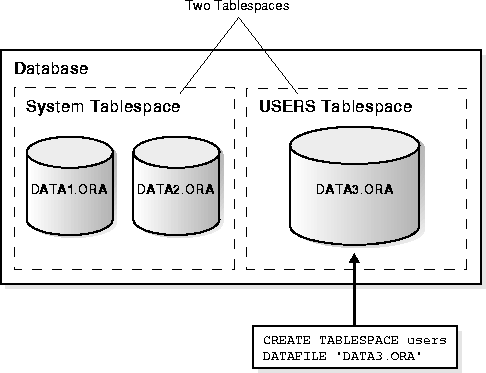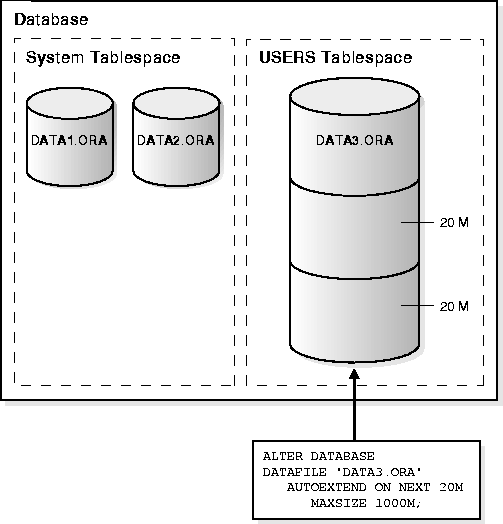Release 8.0
A58227-01
Library |
Product |
Contents |
Index |
| Oracle8 Concepts Release 8.0 A58227-01 |
|
Space - the final frontier . . .
Gene Roddenberry: Star Trek
This chapter describes tablespaces, the primary logical database structures of any Oracle database, and the physical datafiles that correspond to each tablespace. The chapter includes:
Oracle stores data logically in tablespaces and physically in datafiles associated with the corresponding tablespace. Figure 3-1 illustrates this relationship.

Databases, tablespaces, and datafiles are closely related, but they have important differences:
The following sections further explain tablespaces and datafiles.
A database is divided into one or more logical storage units called tablespaces. The database administrator (DBA) uses tablespaces to:
A DBA can create new tablespaces, add datafiles to tablespaces, set and alter default segment storage settings for segments created in a tablespace, make a tablespace read-only or read-write, make a tablespace temporary or permanent, and drop tablespaces.
This section includes the following topics:
Tablespaces are divided into logical units of storage called segments, which are discussed in detail in Chapter 2, "Data Blocks, Extents, and Segments".
Every Oracle database contains a tablespace named SYSTEM, which Oracle creates automatically when the database is created. The SYSTEM tablespace always contains the data dictionary tables for the entire database.
A small database might need only the SYSTEM tablespace; however, Oracle Corporation recommends that you create at least one additional tablespace to store user data separate from data dictionary information. This gives you more flexibility in various database administration operations and reduces contention among dictionary objects and schema objects for the same datafiles.
|
Note: The SYSTEM tablespace is always online when the database is open. See "Bringing Tablespaces Online and Offline" on page 3-7. |
All data stored on behalf of stored PL/SQL program units (procedures, functions, packages, and triggers) resides in the SYSTEM tablespace. If the database will contain many of these program units, the database administrator needs to allow for the space these objects use in the SYSTEM tablespace. For more information about these objects and the space that they require, see Chapter 17, "Procedures and Packages", and Chapter 18, "Database Triggers".
You can enlarge a database in three ways:
When you add another datafile to an existing tablespace, you increase the amount of disk space allocated for the corresponding tablespace. Figure 3-2 illustrates this kind of space increase.

Alternatively, you can create a new tablespace (which contains at lest one additional datafile) to increase the size of a database. Figure 3-3 illustrates this.

The size of a tablespace is the size of the datafile(s) that constitute the tablespace; the size of a database is the collective size of the tablespaces that constitute the database.
The third option is to change a datafile's size or allow datafiles in existing tablespaces to grow dynamically as more space is needed. You accomplish this by altering existing files or by adding files with dynamic extension properties. Figure 3-4 illustrates this.

|
Additional Information:
See the Oracle8 Administrator's Guide for more information about increasing the amount of space in your database. |
A database administrator can bring any tablespace (except the SYSTEM tablespace) in an Oracle database online (accessible) or offline (not accessible) whenever the database is open.
A tablespace is normally online so that the data contained within it is available to database users. However, the database administrator might take a tablespace offline
You cannot take a tablespace offline if it contains any rollback segments that are in use. See "Rollback Segments" on page 2-17 for more information.
When a tablespace goes offline, Oracle does not permit any subsequent SQL statements to reference objects contained in that tablespace. Active transactions with completed statements that refer to data in that tablespace are not affected at the transaction level. Oracle saves rollback data corresponding to those completed statements in a deferred rollback segment (in the SYSTEM tablespace). When the tablespace is brought back online, Oracle applies the rollback data to the tablespace, if needed.
When a tablespace goes offline or comes back online, this is recorded in the data dictionary in the SYSTEM tablespace. If a tablespace was offline when you shut down a database, the tablespace remains offline when the database is subsequently mounted and reopened.
You can bring a tablespace online only in the database in which it was created because the necessary data dictionary information is maintained in the SYSTEM tablespace of that database. An offline tablespace cannot be read or edited by any utility other than Oracle. Thus, tablespaces cannot be transferred from database to database.
|
Additional Information:
Transfer of Oracle data can be achieved with tools described in Oracle8 Utilities. |
Oracle automatically switches a tablespace from online to offline when certain errors are encountered (for example, when the database writer process, DBWn, fails in several attempts to write to a datafile of the tablespace). Users trying to access tables in the offline tablespace receive an error. If the problem that causes this disk I/O to fail is media failure, you must recover the tablespace after you correct the hardware problem.
If you create multiple tablespaces to separate different types of data, you take specific tablespaces offline for various procedures; other tablespaces remain online and the information in them is still available for use. However, special circumstances can occur when tablespaces are taken offline. For example, if two tablespaces are used to separate table data from index data, the following is true:
In summary, if Oracle has enough information in the online tablespaces to execute a statement, it will do so. If it needs data in an offline tablespace, then it causes the statement to fail.
The primary purpose of read-only tablespaces is to eliminate the need to perform backup and recovery of large, static portions of a database. Oracle never updates the files of a read-only tablespace, and therefore the files can reside on read-only media, such as CD ROMs or WORM drives.
Whenever you create a new tablespace, it is always created as read-write. You can change the tablespace to read-only with the READ ONLY option of the ALTER TABLESPACE command, making all of the tablespace's associated datafiles read-only as well. You can use the READ WRITE option to make a read-only tablespace read-write again.
|
Additional Information:
See the Oracle8 SQL Reference for information on the ALTER TABLESPACE command. |
Making a tablespace read-only does not change its offline or online status. Offline datafiles cannot be accessed. Bringing a datafile in a read-only tablespace online makes the file only readable. The file cannot be written to unless its associated tablespace is returned to the read-write state. You can take the files of a read-only tablespace online or offline independently using the DATAFILE option of the ALTER DATABASE command.
Read-only tablespaces cannot be modified. To update a read-only tablespace, you must first make the tablespace read-write. After updating the tablespace, you can then reset it to be read-only.
Because read-only tablespaces cannot be modified, they do not need repeated backup. Also, should you need to recover your database, you do not need to recover any read-only tablespaces, because they could not have been modified. However, read-only tablespaces may need attention during instance or media recovery, depending upon whether and when they have ever been read-write.
You can drop items, such as tables and indexes, from a read-only tablespace, just as you can drop items from an offline tablespace. However, you cannot create or alter objects in a read-only tablespace.
You cannot add datafiles to a read-only tablespace, even if you take the tablespace offline. When you add a datafile, Oracle must update the file header, and this write operation is not allowed in a read-only tablespace.
You can manage space for sort operations more efficiently by designating temporary tablespaces exclusively for sorts. Doing so effectively eliminates serialization of space management operations involved in the allocation and deallocation of sort space. All operations that use sorts - including joins, index builds, ordering (ORDER BY), the computation of aggregates (GROUP BY), and the ANALYZE command to collect optimizer statistics - benefit from temporary tablespaces. The performance gains are significant in Oracle Parallel Server environments.
A temporary tablespace can be used only for sort segments. (It is not the same as a tablespace that a user designates for temporary segments, which can be any tablespace available to the user.) No permanent objects can reside in a temporary tablespace. Sort segments are used when a segment is shared by multiple sort operations. One sort segment exists in every instance that performs a sort operation in a given tablespace.
Temporary tablespaces provide performance improvements when you have multiple sorts that are too large to fit into memory. The sort segment of a given temporary tablespace is created at the time of the first sort operation. The sort segment expands by allocating extents until the segment size is equal to or greater than the total storage demands of all of the active sorts running on that instance.
You create temporary tablespaces using the following SQL syntax:
CREATE TABLESPACE tablespace TEMPORARY | PERMANENT;
You can also alter a tablespace from PERMANENT to TEMPORARY or vice versa using the following syntax:
ALTER TABLESPACE tablespace TEMPORARY;
|
Additional Information:
See Oracle8 SQL Reference for more information on the CREATE TABLESPACE and ALTER TABLESPACE commands. |
A tablespace in an Oracle database consists of one or more physical datafiles. A datafile can be associated with only one tablespace and only one database.
Oracle creates a datafile for a tablespace by allocating the specified amount of disk space plus the overhead required for the file header. When a datafile is created, the operating system in which Oracle is running is responsible for clearing old information and authorizations from a file before allocating it to Oracle. If the file is large, this process might take a significant amount of time.
The first tablespace in any database is always the SYSTEM tablespace, so Oracle automatically allocates the first datafiles of any database for the SYSTEM tablespace during database creation.
When a datafile is first created, the allocated disk space is formatted but does not contain any user data; however, Oracle reserves the space to hold the data for future segments of the associated tablespace - it is used exclusively by Oracle. As the data grows in a tablespace, Oracle uses the free space in the associated datafiles to allocate extents for the segment. See Chapter 2, "Data Blocks, Extents, and Segments", for more information.
The data associated with schema objects in a tablespace is physically stored in one or more of the datafiles that constitute the tablespace. Note that a schema object does not correspond to a specific datafile; rather, a datafile is a repository for the data of any object within a specific tablespace. Oracle allocates space for the data associated with an object in one or more datafiles of a tablespace. Therefore, an object can "span" one or more datafiles. Unless table "striping" is used (where data is spread across more than one disk), the database administrator and end users cannot control which datafile stores an object.
You can alter the size of a datafile after its creation or you can specify that a datafile should dynamically grow as schema objects in the tablespace grow. This functionality enables you to have fewer datafiles per tablespace and can simplify administration of datafiles.
|
Additional Information:
See the Oracle8 Administrator's Guide for more information about resizing datafiles. |
You can take tablespaces offline (make unavailable) or bring them online (make available) at any time except SYSTEM. All datafiles making up a tablespace are taken offline or brought online as a unit when you take the tablespace offline or bring it online, respectively. You can take individual datafiles offline; however, this is normally done only during some database recovery procedures.